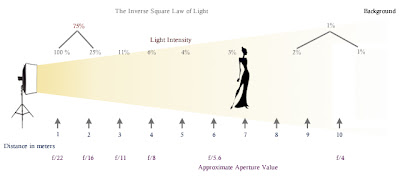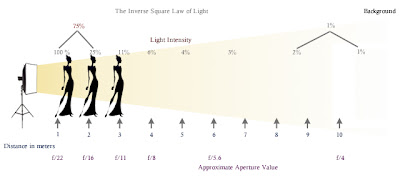So in the previous article, The Inverse Square Law of Light, we discussed the theory, now let us take a look at how we put what we have learned to practice. We are now clear that the power of the light will be inversely proportional to the square of the distance.
Let us see how the inverse square law affects Exposure.
 |
| Effect of Inverse Square Law - Exposure |
It is clear from the above diagram that the strobe has its maximum output in close ranges, but its intensity falls off quickly as the distance increases. Also the rate at which the intensity is decreasing also decreases with distance. See at first when distance is increased from one meter to two meters, there is 75% drop in power. But when it is far like say when the distance is increased from eight to ten meters (2 meter increase) then the power is only reduced by 1 %. Assuming all other aspects including shutterspeed remains the same; at one meter from the strobe we are getting a metering of f/22 and at 10 meters f/4.
Lighting a Single Subject
When you are shooting a single person, if you position your subject very close to the light, then even slight movements by the subject could throw your exposure out by a big margin. Assuming you are working with a model; if she moves a bit towards the light then she will be massively overexposed and if she moves away from the light she will be massively underexposed.
 |
| The Inverse Square Law of Photography - Subject Positioned Near the Light Source |
But if you position your subject further away from the light source then even if the subject moves a couple of steps, they will still be exposed properly.
 |
| Inverse Square Law and Photography - Subject Positioned Farther From the Light Source |
Lighting Groups of People
When lighting groups of people you are presented with the same problem, you will have people who are near the light and people who are further away. If you position your group very near to the light source, then what happens is there will be a huge difference in exposure values from the first person the light reaches to the last one. Mostly you will get either some people underexposed or some overexposed; depending on how you set your exposure.
 |
| Inverse Square Law of Light - Effect When Subjects are Positioned Near the Light Source |
In the diagram given above the exposure values for the first person is around f/22 and the third one is around f/11 making it impossible to expose all three properly.
 |
| Inverse Square Law - Effect of Light on Subjects Positioned Farther From the Light Source |
We solved the problem by moving the group farther away from the light, that way now we have all three of them within the exposure value of f/5.6.
Using the Inverse Square Law when Lighting Backgrounds
Most photographers would love to play with light, and prefer to light their main subject a stop or two brighter than their backgrounds or other elements. But there are times when you would want your background also to be well lit.
When you want your subject to be bright and background to be dark, place your subject nearer to the light, farther from the background.
 |
| Inverse Square Law - Subject Positioned Near the Light Source and Away from the Background |
The further you place your model from the background, the greater will be the difference in exposure values.
When you want your background also to be lit brightly, place your model farther from the light source and closer to the background.
When you want your background also to be lit brightly, place your model farther from the light source and closer to the background.
 |
| Inverse Square Law - Subject Positioned Away from the Light Source and Near to the Background |
This way you now have both the subject and the background evenly lit.
In the next article we will discuss about Quality Of light - Opacity
In the next article we will discuss about Quality Of light - Opacity
Related Reading
- An Introduction to Light
- Wavelengths and Colours
- What Happens When Light Falls On a Surface
- Quality Of Light
- Shadows